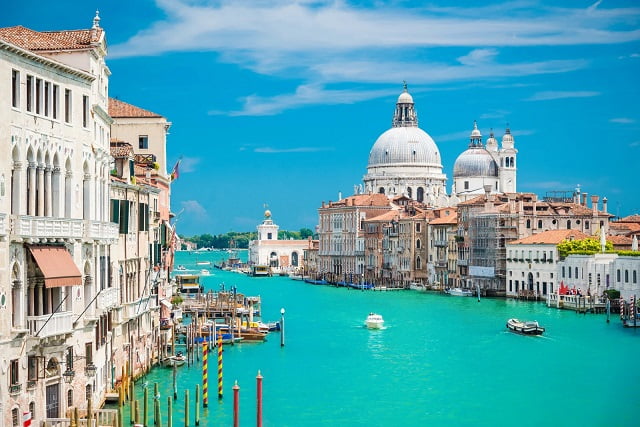Are you curious about how much it costs to travel to Italy? In this traveler’s guide to budgeting, we will explore the various expenses you can expect when visiting this beautiful country. From accommodations and transportation to dining and sightseeing, we’ll provide you with valuable tips for experiencing Italy on a budget.
Italy is a dream destination for many travelers, with its rich history, stunning landscapes, and mouthwatering cuisine. However, the cost of traveling to Italy can vary greatly depending on your preferences and travel style. Whether you’re a budget-conscious backpacker or looking for a more luxurious experience, it’s important to plan and budget accordingly.
In this comprehensive guide, we will break down the costs associated with different aspects of travel in Italy. From planning your itinerary and choosing the right accommodations to navigating transportation options and experiencing the best of Italian cuisine, we’ll help you make informed decisions to ensure an unforgettable trip without breaking the bank. So let’s dive in and discover how much it really costs to travel to Italy.
Planning Your Itinerary
Italy is a country that offers a diverse range of experiences for travelers, from the romantic canals of Venice to the ancient ruins of Rome. When planning your itinerary for a trip to Italy, it’s important to consider the different regions of the country and what each one has to offer.
In Northern Italy, you can explore the picturesque lakes region, including Lake Como and Lake Garda, as well as visit vibrant cities like Milan and Turin. Central Italy is home to iconic destinations such as Florence, with its wealth of Renaissance art and architecture, and Tuscany’s rolling countryside dotted with vineyards. Meanwhile, Southern Italy boasts the stunning Amalfi Coast, the historic city of Naples, and the island of Sicily.
Each region has its own unique attractions and charm, so it’s worth taking the time to carefully plan your itinerary based on your interests and preferences. Whether you’re interested in history and culture, outdoor activities, or simply soaking up the Mediterranean sun, there’s something for everyone in Italy.
| Region | Average Accommodation Cost Per Night |
|---|---|
| Northern Italy | $100 – $200 |
| Central Italy | $80 – $150 |
| Southern Italy | $70 – $120 |
Accommodation Options
When planning a trip to Italy, one of the most important considerations is accommodation. The good news is that Italy offers a wide range of options to suit every budget, from budget hostels to luxury hotels.
Budget travelers will find plenty of affordable options, including hostels, guesthouses, and budget hotels. Prices for these accommodations can range from $20 to $80 per night, depending on the location and season. For those looking for a more unique experience, Italy also offers agriturismos, which are farm stays that provide an authentic glimpse into Italian rural life at affordable rates.
On the other end of the spectrum, Italy is home to some of the world’s most luxurious hotels and resorts, especially in popular tourist destinations like Rome, Florence, and Venice. These accommodations offer top-notch amenities, stunning views, and impeccable service for travelers willing to splurge on their stay.
No matter what your budget may be, it’s important to book your accommodation well in advance to secure the best rates and availability. Many popular destinations in Italy can get fully booked during peak travel seasons, so planning ahead is key.
| Accommodation Type | Estimated Cost Range |
|---|---|
| Hostels/Guesthouses | $20-$80 per night |
| Agriturismos (Farm Stays) | $50-$100 per night |
| Luxury Hotels/Resorts | $200-$800+ per night |
Overall it is advisable that when preparing for your travels you should consider all aspects such as transportation costs or airfare cost if applicable before deciding how much cost to travel to Italy because with proper planning going through this beautiful country won’t necessarily have a significant impact on your wallet unless you so choose.
Transportation Costs
When it comes to exploring Italy, transportation costs can make up a significant portion of your travel budget. Fortunately, Italy offers a variety of options for getting around the country, whether you prefer the convenience of trains, the flexibility of buses, or the freedom of renting a car. Here’s a breakdown of how much each option might cost and some tips for making the most of your travel budget.
Train Travel
Italy boasts an extensive and efficient rail network that connects major cities and smaller towns across the country. Traveling by train is a popular choice for many visitors due to its convenience and scenic routes. The cost of train tickets in Italy varies depending on factors such as the distance traveled and the class of service. For example:
- Regional trains offer affordable fares for short-distance trips within a specific region.
- High-speed trains like Frecciarossa and Italo provide faster travel between major cities but may come with a higher price tag.
Bus Travel
In addition to trains, buses are another economical way to travel within Italy, especially to destinations that are not serviced by the rail network. Bus companies like FlixBus and MarinoBus operate routes connecting various cities and towns at competitive prices. While bus travel may take longer than trains, it can be a cost-effective option for budget-conscious travelers.
Car Rentals
For travelers who prefer more flexibility in their itinerary, renting a car in Italy allows for independent exploration at your own pace. However, it’s important to consider additional costs such as fuel, tolls, and parking fees when budgeting for car rental in Italy. Keep in mind that driving in busy urban centers like Rome or Florence may also come with its own set of challenges.
Overall, understanding the pros and cons of each transportation option can help you decide which mode of travel best fits your budget and preferences when visiting Italy. By comparing prices and considering factors like convenience and accessibility, you can make informed decisions on how to navigate Italy without breaking the bank.
Food and Dining
When traveling to Italy, one of the greatest joys is sampling the country’s delicious culinary delights. From pasta and pizza to gelato and espresso, Italian cuisine is not only a delight for the taste buds but also an integral part of the travel experience. Fortunately, it is possible to enjoy the best of Italian food without breaking the bank. Here are some tips for sampling Italy’s culinary delights on a budget:
- Opt for local trattorias and osterias: Instead of dining at touristy restaurants in popular areas, seek out local trattorias and osterias where you can enjoy authentic Italian dishes at more affordable prices.
- Explore street food options: Italy is known for its delicious street food, such as arancini, panini, and supplì. Sampling street food is not only budget-friendly but also allows you to experience everyday Italian cuisine.
- Visit markets and grocery stores: Visiting local markets and grocery stores can be a great way to experience Italian cuisine on a budget. You can purchase fresh produce, cheese, and bread to create your own picnic or meal, allowing you to enjoy high-quality ingredients without paying restaurant prices.
It’s important to remember that dining out in Italy can add up quickly if you’re not mindful of your expenses. Be sure to set a daily food budget and stick to it by choosing affordable dining options and being selective about splurging on higher-end meals.
When it comes to drinks, opt for house wines or local beers rather than pricey cocktails or imported beverages. Additionally, consider enjoying an authentic Italian espresso at a local café instead of indulging in expensive specialty coffee drinks.
By being conscious of where and what you eat, travelers can fully savor Italy’s culinary offerings while staying within their budget. With a bit of planning and creativity, it is entirely possible to enjoy the best of Italian cuisine without overspending.
Sightseeing and Attractions
When planning a trip to Italy, it’s essential to budget for sightseeing and attractions. Italy is home to some of the world’s most iconic landmarks, and while many are worth the visit, admission fees can add up quickly. Whether you’re exploring the ancient ruins of Rome, marveling at the art in Florence, or taking a gondola ride in Venice, it’s crucial to plan ahead for these expenses.
One of the most famous attractions in Italy is the Colosseum in Rome. Admission to this ancient amphitheater typically costs around €12-€16 for adults and includes access to the Roman Forum and Palatine Hill. Similarly, entrance fees for the Vatican Museums and Sistine Chapel can range from €14-€20, depending on the time of year and any special exhibitions that may be on display.
In Florence, art enthusiasts won’t want to miss out on visiting the Uffizi Gallery or Accademia Gallery to see masterpieces like Michelangelo’s David. Admission fees for these museums can range from €12-€20 per person. Meanwhile, a visit to Venice wouldn’t be complete without seeing St. Mark’s Basilica or taking a tour of Doge’s Palace – both of which have admission fees ranging from €5-€15 per person.
Ultimately, when budgeting for sightseeing and attractions in Italy, it’s crucial to prioritize your must-see landmarks and research their admission fees ahead of time. By planning your itinerary carefully and setting aside funds specifically for these expenses, you can ensure that you make the most of your trip without overspending.
Day-to-Day Expenses
When traveling to Italy, it’s important to budget for day-to-day expenses such as shopping and entertainment in addition to the big-ticket items like accommodation and transportation. Italy is a country known for its vibrant street markets, designer boutiques, and bustling entertainment scene, so it’s easy to get caught up in the excitement and overspend. Here’s a guide on how to enjoy these daily activities without breaking the bank.
Shopping in Italy
Italy is a shopper’s paradise with options ranging from high-end fashion stores to local markets selling handcrafted goods. If you’re looking to take home some souvenirs without busting your budget, consider visiting the local markets and bargaining for a better price. Additionally, keep an eye out for outlet stores or end-of-season sales where you can score great deals on designer items.
Entertainment and Nightlife
Italy is also known for its vibrant nightlife scene with numerous bars, clubs, and live music venues. While it can be tempting to splurge on drinks or entrance fees, there are ways to enjoy the nightlife without overspending. Look for happy hour deals or free events happening in the city you’re visiting. Additionally, consider exploring outdoor activities such as taking evening walks along the scenic streets or enjoying free cultural performances that many Italian cities offer.
Miscellaneous Daily Expenses
In addition to shopping and entertainment, don’t forget to budget for other daily expenses such as public transportation, tips at restaurants, and incidentals like sunscreen or bottled water. Keep track of your spending by setting a daily allowance for these miscellaneous expenses and stick to it as much as possible. By paying attention to these small but significant costs, you’ll be able to stay within your budget while still enjoying all that Italy has to offer.
Tips for Saving Money
When traveling to Italy, it’s important to consider the various ways you can save money and stick to your budget. From finding affordable accommodations to opting for cost-effective transportation options, there are several insider tips and tricks that can help you make the most of your trip without breaking the bank.
Booking in Advance
One of the best ways to save money when traveling to Italy is by booking your accommodations, transportation, and attractions in advance. By planning ahead, you can take advantage of early bird specials, discounted rates, and promotional offers that can significantly reduce your overall expenses. Additionally, booking in advance allows you to secure the best deals on popular activities and attractions, ensuring that you don’t overspend during your trip.
Exploring Off-Season
Traveling during the off-season can also help you save a significant amount of money on your trip to Italy. Not only will you find lower prices on flights and accommodations, but you’ll also enjoy shorter lines at popular tourist destinations and have a more authentic experience by interacting with locals rather than fellow tourists.
Whether it’s wandering through charming Italian villages or enjoying a peaceful day at the beach, exploring off-season can provide a unique and budget-friendly experience.
Eating Like a Local
When it comes to dining in Italy, eating like a local is not only an authentic experience but also a budget-friendly option. Skip the touristy restaurants in favor of family-owned trattorias and osterias for delicious meals at more reasonable prices.
Opt for lunch specials or “menu del giorno” offerings, which typically include multiple courses at a fixed price. Additionally, visiting local markets and grocery stores for fresh produce, bread, cheese, and other essentials can help you save money on snacks and light meals while exploring the city.
By following these insider tips and tricks for traveling on a budget in Italy – such as booking in advance, exploring off-season, and eating like a local – you can make the most of your trip without overspending. These strategies allow you to enjoy all that this beautiful country has to offer while keeping your overall costs under control.
Conclusion
In conclusion, traveling to Italy can be a delightful experience without breaking the bank if you plan wisely. From exploring the diverse regions of this beautiful country to enjoying the culinary delights and visiting iconic landmarks, there are plenty of budget-friendly options available for every traveler. When considering how much cost to travel to Italy, it’s essential to factor in accommodation, transportation, food, sightseeing, and day-to-day expenses.
By planning your itinerary carefully and seeking out budget accommodations such as hostels or guesthouses, you can significantly reduce your overall costs. Utilizing public transportation like trains and buses can also save you money compared to renting a car. Additionally, indulging in local street food or dining at family-run trattorias can provide a taste of Italy’s flavors without breaking the bank.
It’s worth noting that while certain attractions may have admission fees, there are also many free or low-cost activities to enjoy in Italy. Exploring markets, parks, and historical sites can offer a rich cultural experience without draining your wallet. By keeping these tips in mind and being mindful of your spending throughout your trip, you can enjoy all that Italy has to offer while sticking to a budget.
So how much cost to travel to Italy? With careful planning and budgeting, it is possible to have a memorable Italian adventure without overspending.

I’m a passionate traveler, writer, and Italophile. My fascination with Italy’s history, art, and culture has led me on countless adventures across the Italian landscape. Through “I Live Italy,” I share my love for this extraordinary country and aims to inspire others to explore its boundless beauty.




